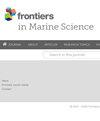北大西洋可持续海藻养殖与气候变化:挑战与机遇
IF 2.8
2区 生物学
Q1 MARINE & FRESHWATER BIOLOGY
引用次数: 0
摘要
作为许多气候问题的解决方案,海藻水产养殖正在全球范围内受到越来越多的关注。然而,海藻本身也受到人为气候变化的威胁。在此,我们总结了海藻水产养殖业面临的与气候有关的挑战,重点关注北大西洋的发展中贸易。具体而言,我们总结了三大挑战:i) 非生物变化;ii) 极端事件;iii) 疾病和食草动物。非生物变化包括海洋变暖和酸化的负面影响,以及海洋变暖导致的季节性变化。这会降低生物量产量,改变海藻的生化成分。极端事件会对海藻养殖场造成巨大破坏和损失,特别是海洋热浪、风暴和淡水输入。在环境压力条件下,如海洋变暖和盐度降低,海藻疾病有更高的扩散几率。食草动物会造成生物量损失,但对北大西洋海藻养殖的研究还不深入。尽管存在挑战,但仍有机会提高对气候变化的适应能力,概括为三部分:i) 面向未来的选址;ii) 养殖和微生物组操作的进步;iii) 恢复性水产养殖。我们介绍了一个案例研究,利用预测建模来说明在未来海洋变暖的情况下,北大西洋适合海藻养殖的栖息地。值得注意的是,适合养殖海藻(Alaria esculenta)和数字层藻(Laminaria digitata)的栖息地大量减少。我们展示了选择和引诱以及微生物接种如何成为一种具有成本效益和可扩展的解决方案,以提高抗病性和耐热性。共同养殖海藻可提高产量和生物多样性的共同效益。最后,我们表明,水产养殖和修复可从合作育苗技术和推动完善立法中受益。本文章由计算机程序翻译,如有差异,请以英文原文为准。
Sustainable seaweed aquaculture and climate change in the North Atlantic: challenges and opportunities
Seaweed aquaculture is gaining traction globally as a solution to many climate issues. However, seaweeds themselves are also under threat of anthropogenically driven climate change. Here, we summarize climate-related challenges to the seaweed aquaculture industry, with a focus on the developing trade in the North Atlantic. Specifically, we summarize three main challenges: i) abiotic change; ii) extreme events; and iii) disease & herbivory. Abiotic change includes negative effects of ocean warming and acidification, as well as altered seasonality due to ocean warming. This can lower biomass yield and change biochemical composition of the seaweeds. Extreme events can cause considerable damage and loss to seaweed farms, particularly due to marine heatwaves, storms and freshwater inputs. Seaweed diseases have a higher chance of proliferating under environmentally stressful conditions such as ocean warming and decreased salinity. Herbivory causes loss of biomass but is not well researched in relation to seaweed aquaculture in the North Atlantic. Despite challenges, opportunities exist to improve resilience to climate change, summarized in three sections: i) future proof site selection; ii) advances in breeding and microbiome manipulation; and iii) restorative aquaculture. We present a case study where we use predictive modelling to illustrate suitable habitat for seaweed cultivation in the North Atlantic under future ocean warming. Notably, there was a large loss of suitable habitat for cultivating Alaria esculenta and Laminaria digitata . We show how selection and priming and microbe inoculates may be a cost-effective and scalable solution to improve disease- and thermal tolerance. Co-cultivation of seaweeds may increase both yield and biodiversity co-benefits. Finally, we show that aquaculture and restoration can benefit from collaborating on nursery techniques and push for improved legislation.
求助全文
通过发布文献求助,成功后即可免费获取论文全文。
去求助
来源期刊

Frontiers in Marine Science
Agricultural and Biological Sciences-Aquatic Science
CiteScore
5.10
自引率
16.20%
发文量
2443
审稿时长
14 weeks
期刊介绍:
Frontiers in Marine Science publishes rigorously peer-reviewed research that advances our understanding of all aspects of the environment, biology, ecosystem functioning and human interactions with the oceans. Field Chief Editor Carlos M. Duarte at King Abdullah University of Science and Technology Thuwal is supported by an outstanding Editorial Board of international researchers. This multidisciplinary open-access journal is at the forefront of disseminating and communicating scientific knowledge and impactful discoveries to researchers, academics, policy makers and the public worldwide.
With the human population predicted to reach 9 billion people by 2050, it is clear that traditional land resources will not suffice to meet the demand for food or energy, required to support high-quality livelihoods. As a result, the oceans are emerging as a source of untapped assets, with new innovative industries, such as aquaculture, marine biotechnology, marine energy and deep-sea mining growing rapidly under a new era characterized by rapid growth of a blue, ocean-based economy. The sustainability of the blue economy is closely dependent on our knowledge about how to mitigate the impacts of the multiple pressures on the ocean ecosystem associated with the increased scale and diversification of industry operations in the ocean and global human pressures on the environment. Therefore, Frontiers in Marine Science particularly welcomes the communication of research outcomes addressing ocean-based solutions for the emerging challenges, including improved forecasting and observational capacities, understanding biodiversity and ecosystem problems, locally and globally, effective management strategies to maintain ocean health, and an improved capacity to sustainably derive resources from the oceans.
 求助内容:
求助内容: 应助结果提醒方式:
应助结果提醒方式:


